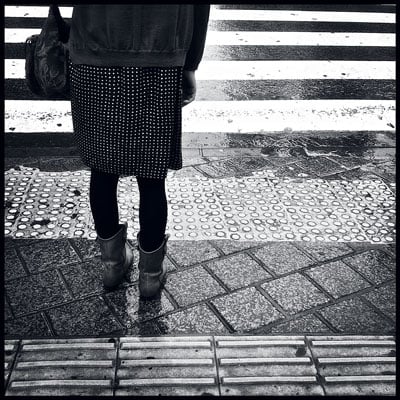
This isn’t my story to tell. It belongs to my sister-in-law, Marsha, because she’s the one who learned to overcome her fear of crossing Bradley Boulevard in downtown Bethesda. It’s Marsha whose brain demands she parrot every word spoken to her and who is endlessly frustrated when people cut her off mid-sentence. She calls her processing disability her “special source,” likely because she grew up in the ’60s, before autism-spectrum disorder became a common term.
After my in-laws died, my husband and I inherited Marsha’s care. Two years ago, we moved her from Syracuse to Bethesda. Though she’d been on her own for years, she wowed us with the skills she acquired post-move: mastering an ATM, navigating two buses to her day program, scheduling visits to the woman who waxes her lip and chin (and sometimes too much of her eyebrows).
Yet she couldn’t navigate the Bradley Boulevard crosswalk near her apartment. DON’T WALK flashed before she made it across, and she couldn’t convince herself it was safe to continue. (She’s so literal that when her aunt in Syracuse suggested she buy a cart to carry groceries home, she talked Wegmans into selling her one.) She’d stop at the median, or run back to Safeway to beg for help. She phoned daily to tell us she’d gotten hysterical.
So one Sunday my husband, our son and daughter, and I picked up Marsha and walked with her to Bradley. We timed the green light and her walk across. “You have plenty of time,” I said. The five of us crossed together, my son and husband holding her hand. After a few passes, we asked if she was ready to tackle it alone. “That I am,” she said.
My daughter and I stood on one side of the street, my husband and son on the other. The light turned, and Marsha stepped off. When she reached the corner, we high-fived her. “I think I’ll try this baby again,” she said when walk appeared. She took off across the street, her shoulders thrust back.
The next morning, a woman called to say she’d found Marsha crying on the intersection’s island. She put Marsha on the phone. “I had a sidestep,” she said apologetically. But the next day she returned to Bradley, and we haven’t gotten a call since.
I’m not going to ennoble Marsha, because writing about lessons from a disabled person is reductive. I also don’t want to give myself more credit than I deserve—my husband is Marsha’s primary caregiver.
There was a time when I feared Marsha as much as she feared Bradley Boulevard. I was afraid I’d bear children with her disability, and when this didn’t happen, I feared being her caregiver: I would become my mother-in-law, who argued with and loved Marsha at full decibel; my husband would be his father, bowed from the heft of Marsha’s needs. Sometimes I see my in-laws’ fatigue in his eyes, so I fill in his silences and tell myself I’m contributing to Marsha’s care.
Now the blood disorder she’s been managing has progressed. She knows her spleen is large and she needs to visit the doctor more often to monitor her platelet counts. Her fear of dying lodges itself between the cracks of family memories—b’nai mitzvahs she wasn’t invited to, a wedding where she was so overmedicated she couldn’t swallow her food. She calls often to rehash these incidents and, when she’s anxious, participates less in dinner conversations, opting to hum jingles or watch Brady Bunch DVDs with our kids.
While I don’t own Marsha’s story, her “special source” is a thread that binds her not only to my husband but also to my children and me. I couldn’t rip this seam if I wanted to. So we’ll continue to accompany Marsha to difficult intersections—and stand beside her until it’s time to cross.
Michelle Brafman lives in Glen Echo and teaches fiction writing at Johns Hopkins and GW. Her website is michellebrafman.com.
This article appears in the February 2014 issue of Washingtonian.
















